

Minecraft first came out in 2009; but just a few weeks ago it debuted on the current console generation. What makes this game endure, 5 years later – with over 15 million licensed players on the PC/Mac alone? It’s awesome, that’s what. If you’re late to the party though, don’t worry – this extensive beginner’s guide has you covered.
It easy to dismiss Minecraft as an indie game that really ought to have hired some better digital artists, but if you can get past the giant blocks of ugliness you’ll be sure to find at least one aspect of the game that really appeals.
For some, it’s about the adventure. Every world is procedurally generated from a random string of numbers – the seed variable. You need never play on the same map twice – but if you do find an intriguing world online (try searching for “Minecraft seed catalogue”), all you need to do is copy down the seed number and you’ll be able to create your own copy that world (of how it started out at least, you won’t actually be playing on someone else’s map, and their modifications and buildings won’t exist in yours).
For others, it’s the creative freedom allowed. Every part of the map can be dug up, cut down, and reconstructed as your imagination desires. It’s the complete digital Lego set you always wanted – and just as with it’s physical counterpart, there’s some incredibly talented builders and architects out there.
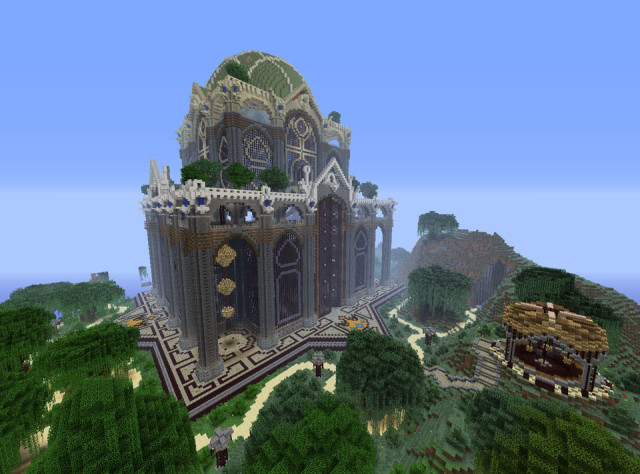
For others, it’s about mastering the complex systems of crafting redstone machines, or the simple pleasures of farming – establishing a sustainable food and resource chain. You can go as deep into the rabbit hole as you like, because there’s an awful lot there. And that’s not even touching on multiplayer or mods (modifications that change core gameplay or add additional features). Minecraft is available for Windows, OSX, Linux, all popular consoles except the Wii U, iOS and Android mobile devices.
Mobile versions (the “Pocket Edition”) differ slightly, and this guide was written from the perspective of PC gameplay. Also be aware that development on Minecraft continues, so variations in crafting recipes or gameplay mechanics may exist when a new version is released. This guide was written mainly using version 1.64 (the current version is 1.8), but from a beginners perspective; the core mechanics rarely change, only the higher level items and features.
Upon starting your first Minecraft game you’ll be presented with a choice of game modes.
In this guide, I’ll be talking about Survival mode – the original and most popular.
On the PC, a standard set of WASD keys control movement, with the mouse used to look around. Chopping trees, digging, and mining is all performed by holding down the left mouse button – your character will initiate the activity on whatever block your view in centered on.
When the task is complete, a small resource cube with drop and float. Standing near or walking over this resource cube will add it to your inventory. Attacking is also performed with the left mouse button, though you may find single taps are enough.
Right clicking performs a context sensitive special action. If you’re holding a bucket, a right click will attempt to fill it with whatever you’re aiming at: water, lava, or milk from a cow. If it’s a hoe, the ground will be prepared. If it’s food, you’ll consume it (keep the button down). Bows also fire by holding down the right mouse button then letting go to let loose an arrow. Sometimes it’s not obvious, so if in doubt try the right mouse button first: I’ve had chickens fly around screaming before because I accidentally smacked them with some seeds rather than feeding them.
Crafting is central to playing Minecraft, and it’s useful to learn how to do it before joining your first game. Crafting means taking one or more raw ingredients, and transforming them into something. If the recipe involves more than one ingredient, the ingredients must be placed in a specific pattern. Luckily, the pattern somewhat resembles the final product, so it’s not as difficult to remember the recipes as you might think (which is good, because there are thousands). Here’s some examples for basic tools.
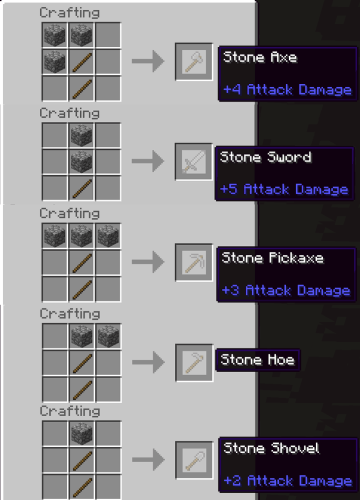
There are usually two wooden sticks that form the handle, then the top part in these screenshots is made of stone. Yes, it’s a stone pickaxe – don’t question the logic. You can make basic tools from wood, stone, iron, gold, and diamond; but they all need wooden sticks to form the handle. Check out the mining chapter for more on durability and required materials for specific blocks.
When you first start the game, your character is able to perform some basic crafting from within the inventory screen – press E to open it. You’ll notice you have a 2×2 block of squares for crafting, so whilst you can make some basic things like turning wood into planks, you can’t actually make tools yet. How do you make tools then? You craft a crafting table.
A crafting table can be made by filling all four of your crafting spaces with planks; so you’ll need four planks to make one table. Once made, place the table by equipping it and right click on an empty space; then right click on the table to open up the larger crafting screen. You now have 3×3 crafting area to work with. Certain items can stack in your inventory, and you’ll see a small white number in the corner indicating how many you have. If you left click to pick up a stack, you’ll pick up everything; if you right click, you’ll pick up half of the items. When putting them down again, left clicking will place them all; but right clicking will place them one-by-one. Placing stacks of ingredients on the crafting area doesn’t change the recipe, but if you place enough stacks to make multiple copies, you can press SHIFT when dragging out the resulting item to create multiples (as many as ingredients and your inventory will allow). Don’t worry if this is confusing – I’ll show you in the video embedded in the “First Night” section later.
The building construction aspect of Minecraft is really so vast that a guide would be pointless. If this is the element of the game that you want to pursue, you can find master classes in building on YouTube from players far more impressive than me.
Suffice to say that one of the first things I built was a huge stone tower to act as a point of reference (finding a little cave can be tough), and from which I could safely watch the sun set and survey the surrounding area. It later expanded into a sky-farm, because why not?
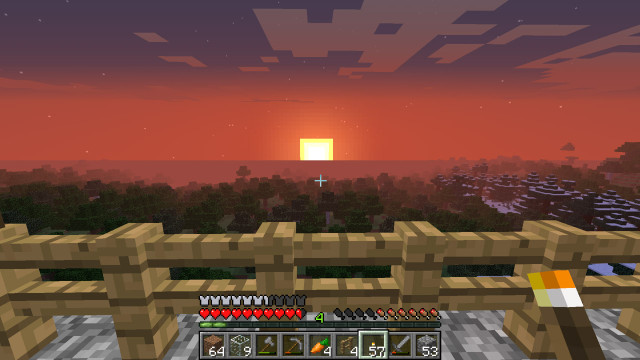
Here’s some crafting recipes you may find useful early in your architectural career:
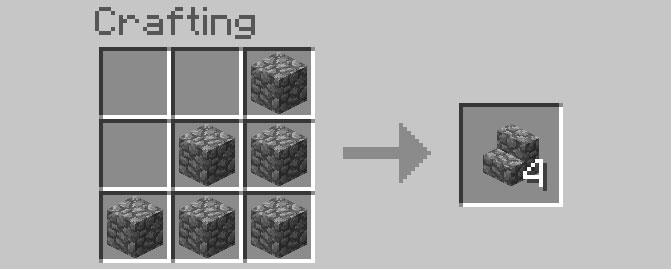

A glass roof to let the natural light shine through
The first night in Minecraft is curiously one of the hardest. You’ll start with nothing (though there is an option to have a small starting chest of goodies, if you wish – I won’t judge), and you must establish a base of operations before night falls and the nasties come out to play (mobs). If you don’t have somewhere to hide, they’ll probably kill you. To do this, you’ll need tools. You have 10 minutes of real world time to do all this.
If you don’t want to watch the video (though I strongly encourage you to) – here’s a rough outline of steps you’ll want to take.
Mobs spawn in the darkness. Torches can be made by placing one coal (or one charcoal) on top of a stick. If you haven’t found coal yet, you can still create charcoal by roasting wood in a furnace. A furnace is an essential item after your first night anyway, but if you need one sooner, craft one from 8 pieces of stone laid around in a square pattern, with one empty square in the middle. The furnace requires fuel at the bottom (you can use wood if you like), and the item you wish to “cook” goes on top. To make charcoal, simply “cook” some wood. The process isn’t particularly efficient, but if you’re desperate it’ll work.
Day 1: My wife, mother-in-law and I jumped into this brave new world. I scouted the spawn area while they got the hang of movement, but the luscious trees meant we had trouble regrouping. After building a tower of dirt to rally them around, the night rapidly approached. We were nowhere near a mountain to hollow out, and still hadn’t created even the most basic of tools, so together we burrowed down into the dirt and buried ourselves in a shallow grave. After fashioning a quick crafting table, I made use of the time to teach them the basics of making wooden tools. In the morning, we ventured out and trekked until we found a mountain that we could call home.
Zombies are relatively easy to fight; just keep hitting them. They are only a problem if 3 or more surround you.
Spiders can be shot from afar or fought in close combat, but try to stay above them where they can’t attack.
The Enderman is a tall, slender black creature with pink eyes, which hates being looked at directly. If you spot them during the day, don’t panic as they aren’t naturally aggressive. If you stare at them, you’re going to die, and they’re almost impossible to kill when you’re a beginner since they teleport. Just don’t look at them, okay?
Creepers are the most dangerous to you early in the game, as they explode and should therefore only be fought from a distance with a bow and arrow, or tricked into falling off things. Don’t take chances with them, especially around your base, as their explosive power can cripple you. You can get gunpowder from them however if you manage to kill them without an explosion.
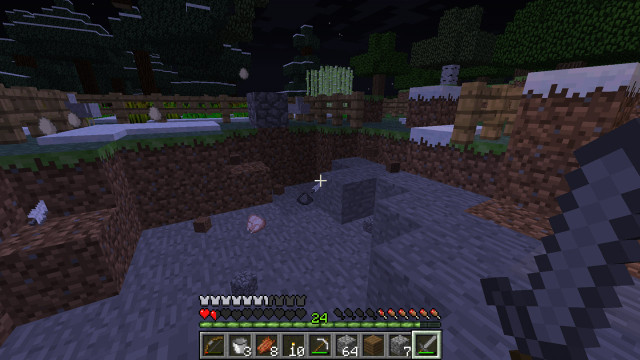
Day 10: I’ve started constructing a huge stone tower, a monument to my power and guide back home. Unfortunately, despite fitting an entirely glass roof, I neglected to install suitable night lighting on the staircase, and we returned one day to find a creeper had spawned. It destroyed 3 beds and a chest, full of our most precious items. We will survive!
Skeletons are also dangerous early in the game, particularly if you come across 2 or more of them at once. If you don’t have a bow and arrow, hide around a corner and lure them to you, picking them off at close range. Each time they hit, you’ll be pushed back a little, so try not to run at them from a distance. If you do die in survival mode, it’s not a complete tragedy: your items will fall to the floor, and you can pick them up again after you respawn.
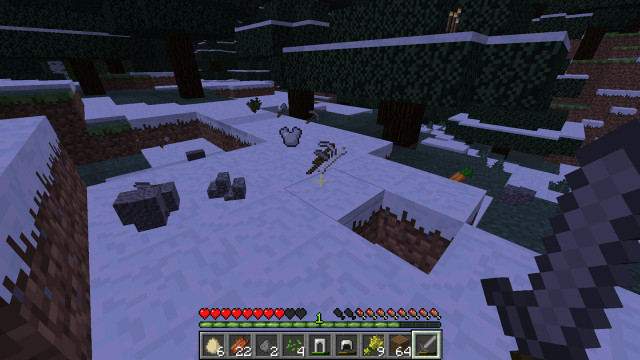
Mobs will spawn wherever there’s darkness: so anywhere outside during night time, and anywhere underground if you haven’t laid torches in your mines (or in your house).
As the name would suggest, mining is kind of a central aspect to Minecraft. In fact, the world extends about 100 layers downward. Although you could play the game by ignoring the mining aspect completely and simply use stone tools, you’ll be missing out on a lot. To build better, more durable tools, you need to dig down – deep, deep down. You can start with just a stone pickaxe – but be careful: while a stone tool is fine for extracting iron and coal, attempting to mine anything else (such as diamond or gold) will result in nothing being produced and the ore will be wasted. To mine other “special” blocks, you need at least an iron pickaxe.
What will you find underground?
A few layers down and sometimes even exposed overground, you’ll find coal and iron ore. Coal is shown as black flecks in the rock; iron is orange flecks. Both can be extracted with a simple stone pickaxe; but the iron ore must be smelted into iron ingots before it can be of any use. The coal is used to smelt it inside a furnace. Place the fuel at on the bottom square, the ore on the top, and wait for it to be transformed.
Ideally, you’ll have started your home where you happened across an outcrop or iron ore or coal, but if not, look around for existing open caves and go spelunking. Remember to lay torches to light your way and prevent mobs spawning – and it’s wise to carry at least a sword in case there are fiends already down there (which there almost certainly are).
For my first foray into mining, I simply started digging diagonally downwards from inside my house; laying torches and stairs as I went. Stairs can be made by arranging 6 stone or wooden blocks into a diagonal stair shape (obviously), enabling you to walk up and down without jumping.
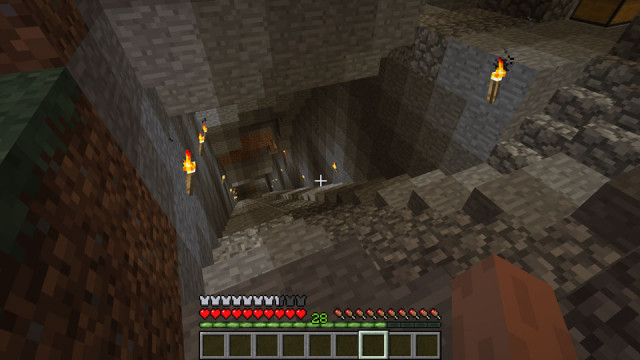
You can also dig straight downwards, though the most important rule in Minecraft is never to dig the block directly beneath you, in case you plummet to your doom in a pool of lava. Digging a shaft at least 2×1 solves this, of course. A ladder can be run to climb back up again, formed from 7 sticks (3, 1, 3)
Farming early on in the game is essential if you don’t want to be forced to go out hunting every time just to eat. If you’re desperate – chickens, pigs, and cows will all provide some good sustenance, but need to be cooked.
The farming of crops basically requires soil, water, and a hoe. Wheat (from seeds), pumpkins, and carrots can also be planted most efficiently in a 9×9 grid with one square of water in the centre. Use a bucket (made from 3 iron ingots in a v-shape), to fetch water from a nearby source. Right click on some ground to prepare it with a hoe, though if there’s snow on top you’ll need to clear that off first. Seeds are the first thing you’ll need to start farming. Seeds are obtained from long grass, but you need to destroy quite a bit to get a few seeds. When fully matured, seeds grow into wheat – tall and yellow, with brown tips. Harvest them at this point to obtain more seeds, and some wheat. Use the wheat to lure cows and sheep. Turn any excess into bread, cakes, cookies, and for breeding.
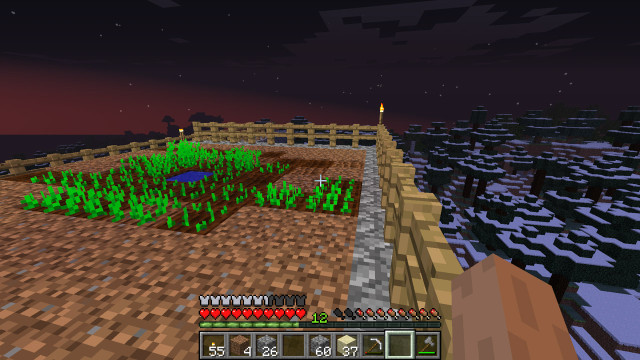
Carrots and potatoes do not occur naturally, and can only be found in villages or as rare drops by zombies. You can eat carrots raw or use them as crafting components; also to lure pigs. Potatoes need to baked before you can eat them. You may also find pumpkins and melons naturally, though the farming of these is a little more complex. Sugar cane is simple to grow in soil or sand, but must be placed directly next to a water source; it’s useful for making sugar, and paper.
You can even grow crops in the sky, safe from predators – but don’t make the same mistake I did and forget to put a solid base layer on it or you’ll soon found you’ve flooded large swathes of land below (it’s funny how much water can pour out of a single bucket).
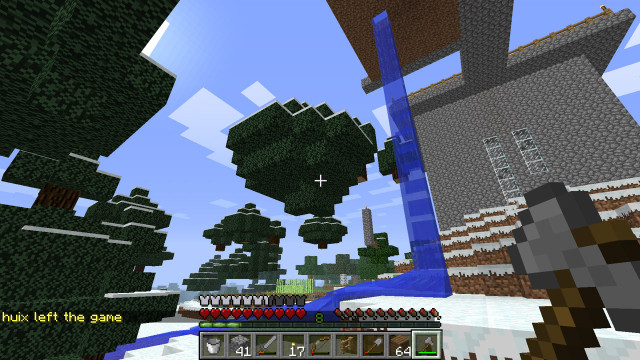
Plants can also be grown indoors or underground provided there’s enough ambient light from torches or glowstones; sunlight is not required.
Day 19: I attempted to build an indoor sugar cane farm above our main residence. My negligent DIY has left it literally raining in the main bedroom. Today I learnt that you need two layers to stop water from leaking.
Chickens are probably your best bet as the first animal to capture and rear. Use seeds, obtained at random by destroying long grass or from your established wheat farm, to lure at least two chickens back to a fenced area. To lure animals, simply equip the relevant item in your hand and walk near them – they will follow, but may go astray if it’s long way. As well as being edible when cooked (4 food), chickens also lay eggs. You could go the boring route and cook the eggs into a cake (or pumpkin pie), but it’s a lot more fun to throw the eggs instead – and there’s a 1 in 32 chance that a chick will emerge!
Here’s what we did: horde a few hundred or so eggs – this should be pretty quick if you’ve lured some back and established a flock. Then we dug a pit in the house, at least two blocks deep so animals can’t climb out. Throw any eggs you get at the walls, and you’ll soon have a pit full of chickens. Plus, you get to smash eggs, which is obviously a lot of fun.
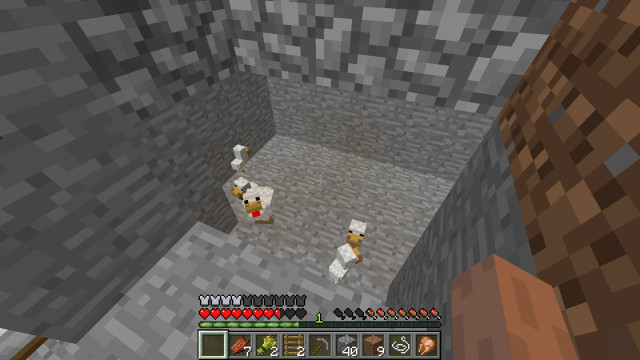
Sheep (lured with wheat) can be sheared to make wool, which combined with planks can make a bed. Best of all, you can dye them pink.
Cows (also lured with wheat) make beef and leather; the leather can be dyed to make light armor. You’ll also find pigs, but these are lured with carrots, so it’s unlikely you’ll capture any until you’ve found a random carrot on a zombie and propagated it a few times.
Getting animals into and keeping them in a pen is more difficult than it sounds. You can use gates, but more often than not I found the silly creatures would follow me back out again, even when I wasn’t holding any seed. Instead, don’t bother with a gate – just place a block one away from either side of the fence, and jump in and out of the pen when needed. All animals can be pushed into reproducing by feeding two of them some of their respective food of choice, so you only ever need 2 animals to start rearing them; there is no male or female.
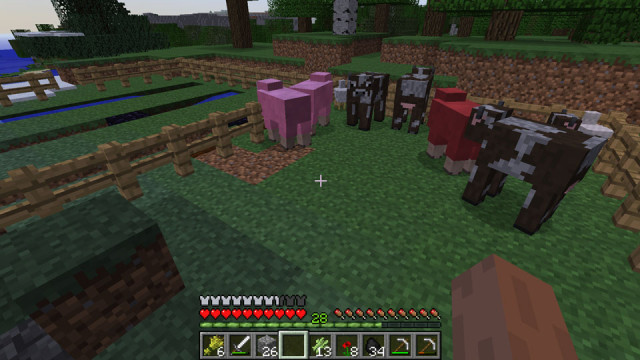
For the ultimate immersive experience, download the MineCrift mod from this MeantToBeSeem forum (requires free registration). You’ll need to have played the game (v.1.7.10) at least once, then drop the included txt file into the Minecraft directory, rename it to a .exe and run it. Next, set up a profile and use the “release-minecrift-1.7.10-PRE3-nohydra” (the latest at the time of writing). For dev kit 2, you must disable the Rift service, and set the Rift in extended desktop mode, but as your primary monitor. Launch Minecraft from within the desktop on the Rift.

At the time of writing, it works with both dev kit 1 and 2, though positional tracking has not yet been implemented. You may also wish to downgrade a number of graphical options from within the OptiFine menu to increase performance, as it’s a lot more demanding than regular Minecraft.
Most people will never need to do this as public servers abound, but if you do want full control – to host a local LAN game or use a specific legacy version (such as the last Oculus Rift compatible server) – you can indeed download and run your own local network dedicated server. Note that this isn’t strictly necessary either: the easiest way to run a LAN game is to select Open Game to LAN from the menu when in a single player game.
If you wish to run a dedicated server or have some other requirements, you’ll need to download the server.exe from Minecraft.net/download, which is version specific. Only the latest version is available from the site, but if you manipulate the URL you can download previous versions.
Upon first launching the server executable, a number of folders and text files will be created in the same folder, so it’s good idea to move it to its own folder somewhere on your hard drive first. The first launch will fail, but that’s ok. It’s made a text file called eula.txt, and you’ll need to open that up and change the false variable to true to indicate that you accept the terms of the license agreement.
Minecraft only costs about $25 and is worth every penny, but if you do have unscrupulous friends running unlicensed copies with whom you’d like to play a local LAN game, just open the config file and change the online-mode to false to bypass any authentication.
From the multiplayer menu, you may not see your server listed, so click Direct Connect. To play from the same machine as the server is running on, simply connect to the address localhost. Connecting from other machines will require you to type in the full local IP address, something like 192.168.0.x. You can find this by typing ipconfig from a command prompt.
You should have everything you need now to get started with Minecraft – to survive the first night, to start mining and establish yourself a food supply.
I’ve referenced the The Gamepedia Minecraft Wiki multiple times already in this guide – I use it as a constant source for recipes or specific farming practices. Also, a good portable resource to keep beside you for quick reference is Explorer HD ($2.99) for the iPad.
That’s it for my beginner’s guide: the rest is a journey for you to travel alone! Good luck!
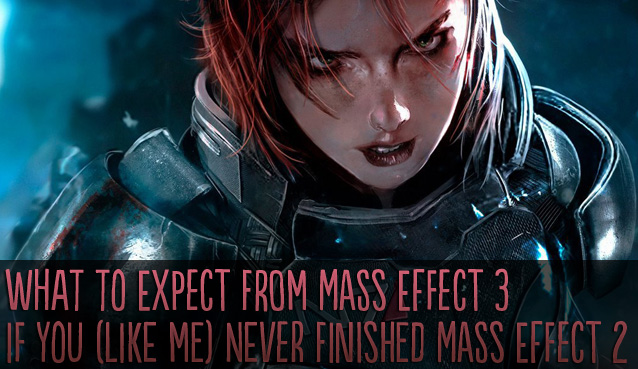


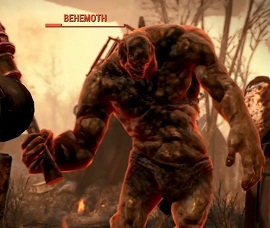
 Murdered: Soul Suspect Review
Murdered: Soul Suspect Review Burn Cards in Titanfall
Burn Cards in Titanfall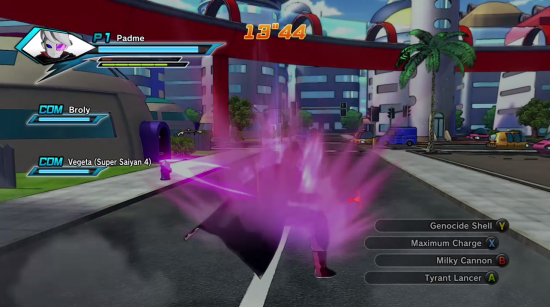 Dragon Ball XenoVerse Guide: How to Choose The Best Skills
Dragon Ball XenoVerse Guide: How to Choose The Best Skills MGS V: The Phantom Pain How to Defeat the Man on Fire in Mission 'The Voices'
MGS V: The Phantom Pain How to Defeat the Man on Fire in Mission 'The Voices' Fable Legends Wiki – Everything you need to know about the game .
Fable Legends Wiki – Everything you need to know about the game .